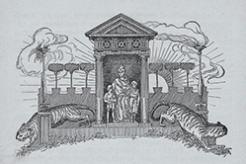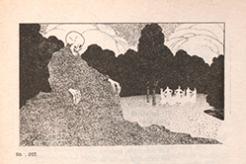




Author: Inta Pujāte, Mag. art.
Myth is an indispensable part of culture since ancient times. It had a particularly important role in the prehistoric era when mythical thinking encompassed almost all spheres of the civilised world: science, art, ethics, medicine and others. In later times, Romanticists actualised the role of myth in the countries dominated by classical culture, as studying folkloric heritage and collecting applied art masters’ works developed in the second half of the 18th and over the 19th century. Spiritual wealth of Oriental countries was also discovered in Europe during this period.
In the early 19th century, these processes reached the Baltic region, causing interest in the language, legends and fairy-tales of local peoples; Baltic Germans began to gather this material but the first professional writers of local ethnicities took over and continued the work on a new level since the mid-century on. Ethnographic materials were also collected, creating an important source for professionally educated Latvian painters and graphic artists who expanded their activities in the late 19th – early 20th century.
This generation set the aim to create a nationally specific art, meaning not just formal experiments but also imagery in line with the nation’s world view, reflecting its emotional experiences. Latvian writer Atis Ķeniņš (1874–1961) expressed this development in a poetic manner in 1906, writing about Fallijs (real name Konrāds Bulāns, 1877–1915): “A poet himself feels his nation’s transcendent aspirations. They crystallise in the symbols generated by the peculiar excitement and philosophy of his poetry. A politician and historian, speaking about the nation’s future, just analyses present and future gains, logically considers means and goals, comparing the struggling powers. A poet does not explain but creates. He himself is a new factor in the nation’s life. He creates truths and beauties that did not exist before. Poetry is the synthesis of the nation’s positive and negative struggle. Led by the spiritual instinct, the genius of nation’s poetry discovers yet unknown islands in an unconscious, almost dreamlike mode. Dreaming about himself, he resolves the mystery of bringing the national spirit to fruition.”[1]
The task of contemporary scholars is to explain the cluster of phenomena that can be named “ethno-symbolism”. Professor Anthony D Smith who is considered the founder of nationalism-related interdisciplinary studies, analyses the development of research focused on ethnic specificity in the second half of the 20th century, concisely formulating the aim of this activity: “…central to the preoccupation of ethno-symbolists is the need to understand the ‘inner world’ of ethnicity and nationalism through an analysis of symbolic elements and subjective dimensions.”[2]
More information will be available in the virtual exhibition, which will be established till April 2016.
[1] Ķeniņš, A. Fallijs. Zalktis, 1906, Nr. 1, 161. lpp.
[2] Smith, D. A. Ethno-symbolism and Nationalism. Abingdon, N.Y.: Routledge, 2009. P. 23.